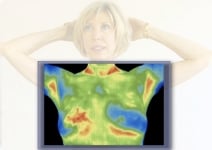by Bruce Rind MD
Why a Breast Thermogram may save your life!
What's the difference between preventive and corrective therapy?  Preventive occurs before the problem while corrective occurs after the problem. Which approach do you prefer? If you said corrective, then this article is not for you. If, however, you prefer preventive care, then this article is what you've been looking for. Breast thermography can see a problem coming on years before it becomes a cancer. This gives us a chance to change the appearance of the thermogram using health giving approaches. Mammography is an important tool but unfortunately, it's best use is to catch the cancer only after it is present and has grown large enough to be picked up by the x-rays. For a woman over 50 years of age, this can mean a wait of 2 years in which the tumor is allowed to grow until it can be detected by this technology. Trying to use mammography for preventive breast health is like trying to drive forward by using the rear view mirror. This is not to say it is not a valuable tool. I use it when it is needed. A hammer is very valuable tool for getting a nail into a board but it is useless if one tries to use it to tighten a bolt. For preventive care, I find that thermography is one of the most valuable tools I have. It doesn't show you a cancer. Instead, it shows you the terrain (in this case, breast) and what is likely going on there, like a weather report. If we worry about rain, we can assess the risk or probability of rain by looking at the sky. If it is a blue sky without any clouds, the risk of rain is nearly '0'. If the sky is dark and we see flashes of lightning in the distance, the risk is very high. Similarly, the thermogram is a risk assessment tool (approved by the FDA for this). It can also monitor changes (i.e., improvement or worsening) in the thermographic breast image to help guide what we are doing.
Preventive occurs before the problem while corrective occurs after the problem. Which approach do you prefer? If you said corrective, then this article is not for you. If, however, you prefer preventive care, then this article is what you've been looking for. Breast thermography can see a problem coming on years before it becomes a cancer. This gives us a chance to change the appearance of the thermogram using health giving approaches. Mammography is an important tool but unfortunately, it's best use is to catch the cancer only after it is present and has grown large enough to be picked up by the x-rays. For a woman over 50 years of age, this can mean a wait of 2 years in which the tumor is allowed to grow until it can be detected by this technology. Trying to use mammography for preventive breast health is like trying to drive forward by using the rear view mirror. This is not to say it is not a valuable tool. I use it when it is needed. A hammer is very valuable tool for getting a nail into a board but it is useless if one tries to use it to tighten a bolt. For preventive care, I find that thermography is one of the most valuable tools I have. It doesn't show you a cancer. Instead, it shows you the terrain (in this case, breast) and what is likely going on there, like a weather report. If we worry about rain, we can assess the risk or probability of rain by looking at the sky. If it is a blue sky without any clouds, the risk of rain is nearly '0'. If the sky is dark and we see flashes of lightning in the distance, the risk is very high. Similarly, the thermogram is a risk assessment tool (approved by the FDA for this). It can also monitor changes (i.e., improvement or worsening) in the thermographic breast image to help guide what we are doing.
Risk Assessment
Thermographic risk is assessed on a scale of 1 to 5. A risk level of 1 or 2 is considered very low (like the clear blue sky) and a woman can be assured with 99% certainty that breast cancer is not present. A mammogram can not tell you that you do not have breast cancer as it is designed to detect the cancer only once it is there and large enough to be seen. A risk level of 5 is associated with a 90% chance that the cancer is already there -- even if it is microscopic and just came on. The mammogram will detect the tumor with 85% accuracy once the tumor is large enough to be seen by it.
Monitoring Breast Health
One interesting characteristic of breast thermography is that it can be used as an ongoing monitor of breast health, like watching the sky for changes in weather. Typically, in my patients, the risk level may be changed by monitoring thermographic changes and making adjustments in the health program to promote healthy changes in the breasts. Thus a woman can, for example, start with a risk level of 4 and after taking action to improve her breast health, she may often see the thermographic image change to a risk level 3 or even 2. A woman starting out with a 1 or 2 is at very low risk and should consider simply continuing to do whatever she is doing since it (lifestyle?) is apparently working for her.
Is thermography invasive?
Thermography does not emit any radiation or x-rays and does not touch the body. It is 100% non-invasive. It simply takes an image produced by your body's own heat and converts it into data that our eye can interpret easily.
Does thermography replace a mammogram?
No, it does not. Thermography and mammography tell us different information about breast health.
---The mammogram is designed to take an image of an object such as a tumor. It tells us something about what the object looks like such as its size, shape or how strongly it blocks x-rays (e.g., if it contains calcium deposits).
---The thermogram gives a physiological description of that is going on in the breast. It can't see a tumor but (like the weather assessment) can tell you what the breast health is doing and monitor if it is becoming healthier or unhealthier over time. Hopefully, if unhealthier, then we do something about it and make it change in a healthier direction.
---An analogy of the above comparison is that if we take a chest x-ray, we can see an (anatomical) image of what the heart looks like. It can show us that there is a heart there, how big it is, where it is located. It can even pick up calcium deposits in the heart. An EKG (electrocardiogram) a physiological expression of 'what the heart is doing' as opposed to how it looks. It tells us if the rhythm is normal, or regular, if the beats appear healthy, certain electrolyte imbalances such as potassium can show up, a variety of electrical conduction disturbances can also be identified. As you can see, these do very different things. Similar to the thermogram, as the doctor initiates a therapy, s/he can monitor the effect or a drug or therapy by using the EKG and note if the heart is functioning healthier or not.
Important last note
Not all thermography systems are equal. Some cameras are not very sensitive and might have poor image resolution or poor thermal resolution. A camera should have an image resolution of at least 80,000 pixels and thermal resolution of no less then 0.1 degrees centigrade. It should have a variety of different palates such as color, grey scale etc. In addition, the thermographer may or may not have the experience and knowledge to guide you toward better health. Some are able to help in this regard. In the future, I plan to have more information on ways to improve breast health. Some of this information will be available on DrRind.com and some of the information will be on NIHADC.com.
.png?width=305&height=132&name=NIHAlogoBLUE_3_transparent%20(2).png)
